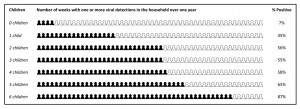U of U Study suggests that big families have viral infections for 87 percent of the year. But only half cause illness.
The BIG LoVE (Utah Better Identification of Germs-Longitudinal Viral Epidemiology) study, led by scientists at the University of Utah School of Medicine, finds that each bundle of joy puts the entire household at increased risk for infection with viruses that cause colds, flu, and other respiratory illnesses.
People living in childless households were infected with viruses on average 3-4 weeks during the year. In households with one child, that number jumped to 18 weeks, and for those with six  children, there was virus in the household for up to 45 weeks out of the year.
children, there was virus in the household for up to 45 weeks out of the year.
Yet on average only half of those who tested positive for viral infection also had the typical symptoms of coughing, fever, and stuffy nose, an informative finding for both families and their health care providers. The results were published in the journal, Clinical Infectious Diseases.
Kids Fill Hearts With Love, And Homes With Illness
When it comes to explaining why big families have more illnesses, all signs point to young kids as the culprits. Tots younger than five had at least one virus detected in their nasal mucus for 50 percent of the year: twice as often as older children and adults. And when infected, they were 1.5 times more likely to have symptoms, including severe ones like wheezing and fever.
Adding even more stress to a household, young kids didn’t suffer alone. Their parents were sick 1.5 times more frequently than similarly aged adults who did not live with young kids.
“A lot families go through wave after wave of illness. In fact, some of the kids we monitored had symptoms for 20 to 25 weeks in a row,” says co-first author Carrie Byington, M.D., professor of pediatrics and co-director of the Utah Center for Clinical and Translational Science. “This study helps us to understand what is normal in young children, and can help us determine when illness should be a cause for concern.”
It’s no secret that children get sick a lot. But BIG LoVE – a year-long survey of a Utah community – is one of the first to use modern diagnostics to track how often kids and other family members, both sick and well, have nasal infections of respiratory virus. Future studies will determine if reported trends hold true in larger and diverse populations.
A Positive Test May Not Mean Positively Sick
Perhaps the most surprising finding was how often participants carried virus, and showed no signs of being sick.
PCR-based diagnostics, like those used to test participants’ samples in this study, are becoming increasingly common in clinical settings because they are much more sensitive and accurate than older tests, and provide results within hours, not days. Yet these findings suggest that some test results should be interpreted with caution.
While study participants infected with influenza and parainfluenza viruses were sick most of the time, those who carried rhinovirus – the cause of the common cold – were only sick half of the time.
What’s more, results suggest that even after a patient recovers from an illness, some viruses persist for weeks afterward. Bocavirus persisted in the nose for as long as 12 weeks, but more commonly viruses persisted for two weeks or less. In an accompanying commentary also published in Clinical Infectious Diseases, Gregory A. Storch, M.D., of Washington University School of Medicine in St. Louis, noted that the research “provides highly useful information,” especially concerning how long PCR-based tests remained positive during each viral episode.
If presence of virus doesn’t always translate into illness, then it stands to reason that even if someone is sick and tests positive for a specific virus, there could be another cause. For example bacteria, or a rare virus not detected by the test. Health care providers should be aware of these limitations.
“If a child comes into the emergency room with severe respiratory illness and tests positive for rhinovirus, it might be a smart idea for doctors to make sure they’re not missing something else that could be the cause,” says co-first author and professor of pediatrics Krow Ampofo, M.B., Ch.B.
How Sickness Was Studied
BIG LoVE was a project to investigate how viruses are transmitted in families. Monitoring a community in Utah, the state with the largest number of children per household, allowed investigators to track differences among big and small families.
Investigators monitored 26 households collectively made up of 108 individuals (three were born during the course of the study) for one year. Each household collected nasal swabs from family members once per week and documented when they had symptoms typical of cold and flu. A PCR-based test, the FilmArray by BioFire Diagnostics, probed swabs for 16 different respiratory viruses, including influenza, rhinovirus, and respiratory syncytial virus (RSV). 4166 samples were analyzed in all. Future studies will examine trends in larger communities, and those in other geographical regions, and of different ethnicities.
Source: University of Utah news release.





No comments